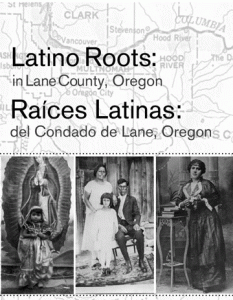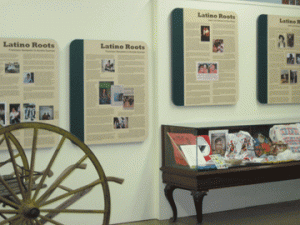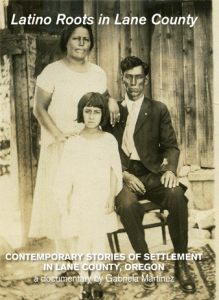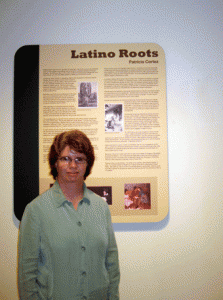a
Latino Roots Project Community Sponsor:
SELCO Community Credit Union
a
a
Latino Roots in Oregon: Brief Project Description
 The Latino Roots Project includes an exhibit composed of fifteen portable wooden panels containing photographs and stories about seven immigrant families; a booklet that captures these same stories and photographs; classes at the University of Oregon; two video documentaries; and a proposed website and digital archive. All materials are bilingual in Spanish and English. The Latino Roots Project is administered through the Center for Latino/a and Latin American Studies (CLLAS). Latino Roots in Oregon Project is a partnership project between CLLAS and the School of Journalism and Communication. The community sponsor is SELCO Community Credit Union. For further information on the project please write to cllas@uoregon.edu
The Latino Roots Project includes an exhibit composed of fifteen portable wooden panels containing photographs and stories about seven immigrant families; a booklet that captures these same stories and photographs; classes at the University of Oregon; two video documentaries; and a proposed website and digital archive. All materials are bilingual in Spanish and English. The Latino Roots Project is administered through the Center for Latino/a and Latin American Studies (CLLAS). Latino Roots in Oregon Project is a partnership project between CLLAS and the School of Journalism and Communication. The community sponsor is SELCO Community Credit Union. For further information on the project please write to cllas@uoregon.edu
 Latino Roots Traveling Exhibit: [Now available in lightweight scrolls.] The original exhibit panels were on display for more than a year at the Lane County Historical Museum (January 2009 through March 2010). These fifteen bilingual (Spanish/English) panels (approximately three feet wide and five feet tall) were part of the exhibit “Changing Demographics: The People of Lane County.” The Latino Roots panels feature a timeline of Latino presence in what is now the state of Oregon beginning in the 1700s, maps, demographic information, information about Latino youth, and the stories of seven families who came at different times to Lane County from California, Texas, Mexico, Guatemala, El Salvador, and Chile. A research team led by CLLAS director Lynn Stephen (Anthropology, Ethnic Studies) created the panels. The team included Gabriela Martínez, Patricia Cortez, Guadalupe Quinn, Mauricio Magaña, Sonia de la Cruz, Kate Williams, Lukacs Nguyen, and Magali Morales.
Latino Roots Traveling Exhibit: [Now available in lightweight scrolls.] The original exhibit panels were on display for more than a year at the Lane County Historical Museum (January 2009 through March 2010). These fifteen bilingual (Spanish/English) panels (approximately three feet wide and five feet tall) were part of the exhibit “Changing Demographics: The People of Lane County.” The Latino Roots panels feature a timeline of Latino presence in what is now the state of Oregon beginning in the 1700s, maps, demographic information, information about Latino youth, and the stories of seven families who came at different times to Lane County from California, Texas, Mexico, Guatemala, El Salvador, and Chile. A research team led by CLLAS director Lynn Stephen (Anthropology, Ethnic Studies) created the panels. The team included Gabriela Martínez, Patricia Cortez, Guadalupe Quinn, Mauricio Magaña, Sonia de la Cruz, Kate Williams, Lukacs Nguyen, and Magali Morales.
 Booklet: The 33-page bilingual “Latino Roots: in Lane County, Oregon/ Raices Latinas: del Condada de Lane, Oregon” booklet is available for download [Latino_Roots_in Lane_ County, Oregon_(book_WEB_update)] on the CLLAS website and for purchase at the University of Oregon Bookstore. It reflects the content of the seventeen panels and can be used with classes who view the panels.
Booklet: The 33-page bilingual “Latino Roots: in Lane County, Oregon/ Raices Latinas: del Condada de Lane, Oregon” booklet is available for download [Latino_Roots_in Lane_ County, Oregon_(book_WEB_update)] on the CLLAS website and for purchase at the University of Oregon Bookstore. It reflects the content of the seventeen panels and can be used with classes who view the panels.
Documentary: “Latino Roots in Lane County: Contemporary Stories of Settlement in Lane County, Oregon” is a 33-minute bilingual documentary that uses in-depth interviewing in the tradition of Latin American testimonio and oral history and was made in conjunction with the museum exhibit. It includes video interviews with six of the families featured in the Latino Roots exhibit panels. Producer and Director: Gabriela Martínez. Assistant Producer: Sonia De La Cruz. Research Team: Lynn Stephen, Gabriela Martínez, Mauricio Magaña, Lukacs Nguyen, Sonia De La Cruz, Guadalupe Quinn. Spanish and English with subtitles.
The film “Latino Roots in Lane County” is also available through the UO Today website.
Latino Roots in Lane County projects were co-sponsored by the Center for Latino/a and Latin American Studies and the Center for the Study of Women in Society.
Latino Roots in Oregon: A Documentary Film Project

“Latino Roots in Oregon” is the working title of a 52-minute documentary by assistant professor Gabriela Martínez, doctoral student Sonia de la Cruz, and local community activist Guadalupe Quinn. The film will be suitable for public television viewing and DVD and Web-streaming distribution. Currently in production phase, this 2009-2010 CLLAS grant-winning project addresses the important but often neglected history of Latin American and Latino settlement in Oregon.
Some came driving cattle with early ranch pioneers along the Siskiyou Trail, some came as mule packers for the U.S. Army, some were Basque sheepherders from the Spanish Pyrenees, and some joined the Bracero Program during WWII and worked the fields and orchards providing manual labor. The ways and times Latinos made their way to Oregon are many and varied and provide for rich story telling as well as a databank for historical purposes.
“Latino Roots in Oregon” is based on extensive research and uses archival materials and in-depth journalistic and ethnographic interviews. An open-access digital archive is part of the overall research project and an important derivative of the fieldwork for the documentary. The archive encompasses moving images, still photographs, documents and text that work together to tell the stories of Latin American and Latino historic and contemporary settlers who call Oregon home. It will be housed in UO Libraries Digital Collections.
Latino Roots Course Sequence
Gabriela Martínez and Lynn Stephen developed a new course sequence at the University of Oregon—“Latino Roots I, Latino Roots II”—first taught during Winter and Spring 2011 through the Department of Anthropology and the School of Journalism and Communication and cross-listed with Ethnic Studies and Latin American Studies. Latino Roots I focuses on giving a theoretical, documentary, and ethnographic understanding of the processes of Latino immigration and settlement in Oregon during the past 150 years. Latino Roots II teaches students how to produce a short video documentary from oral history interviews.
By learning how to conduct A/V digital oral history interviews, edit, and annotate them, students learn Latino history in a hands-on way while they help build this Latino historical record. The assignments cultivate dialogue among the Latino community and wider public with faculty and students connecting Latino community members and the public to their stories.
How to Book Latino Roots Materials
Latino Roots materials (exhibit panels, booklets, films) are available for use in middle schools, high schools, and higher education institutions in the state of Oregon. Curriculum development workshops for training students in how to produce their own Latino Roots stories can also be scheduled with the project research team. To find out more about how to book the Latino Roots in Oregon exhibit, films, and workshops for your school or institution please e-mail: cllas@uoregon.edu

